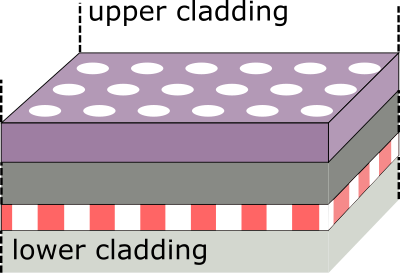legume is a python implementation of the guided-mode expansion (GME) method for simulating photonic crystal slabs, i.e. for multi-layer structures that look something like this
This is an extremely efficient method to obtain the photonic Bloch bands of such structures and can be used to study bulk photonic crystals as well as devices like waveguides and cavities.
The guided-mode expansion is particularly useful for computing the quasi-guided modes above the light line, which are hard to isolate in first-principle finite-difference of finite-element methods. This can be invaluable for the study of the coupling of photonic crystal modes to the radiative environment, and of exotic phenomena like bound states in the continuum.
The GME method can be super useful in itself, but on top of that we also provide a differentiable implementation through the autograd backend. This allows you to compute the gradient of an objective function that depends on any of the ouput parameters (eigenmode frequencies and losses, fields...) with respect to any of the input parameters (hole positions, sizes and shapes, slab thickness...) With this powerful addition, there's no end to the possibilities in using legume to optimize your devices! Inverse design with plane-wave expansion (PWE) and guided-mode expansion (GME) is described in the ACS Photonics paper.
Dive into the :ref:`examples` to see how this all works in practice!
Examples 0.1-0.8 refer to the basics of PWE, GME and inverse design.
The new legume 1.0, submitted to Computer Physics Communications (CPC) introduces the following new features:
- symmetrization with respect to a vertical (kz) mirror plane
- interaction between photonic modes and excitons, leading to photonic crystal polaritons
Important
Examples 1.1-1.6 are all related to the CPC paper.
We implemented a new verbose output built on top of rich. Here's an example:
If you installed rich, but you prefer
the classic verbose output just use the command legume.set_print_backend('base') at the beginnig
of your script.

